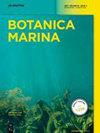南美(巴西)东海岸沙滩上的冲浪硅藻:aululesehrenberg和Asterionellopsis Round的鉴定
IF 1.4
4区 生物学
Q2 MARINE & FRESHWATER BIOLOGY
引用次数: 0
摘要
“冲浪硅藻”可以在世界各地的沙滩冲浪带形成高生物量,巴西的Asterionellopsis和anulus是该群的主要属。冰川Asterionellopsis glacialis被认为是一个世界性的物种,利用分子和形态学手段进行的分类研究表明,冰川Asterionellopsis glacialis是一个由隐种和半隐种组成的复合体。因此,假设南环藻,另一种具有广泛纬度分布的冲浪带斑块形成硅藻也可能是物种复合体的一部分,这是合理的。根据遗传分化、系统发育、单位点自动物种划分方法(两属)和结体超微结构(环孢菌)对南美(巴西)东海岸热带、亚热带和暖温带沙滩上的环孢菌和Asterionellopsis菌株进行鉴定。在热带和亚热带滩地均有1种南环螺,而在不同纬度均有至少3种南环螺,分别为a . tropicalis、a . thurstonii和a . guyunusae,表明南环螺具有不同的生态需求。thurstonii Asterionellopsis先前在欧洲有报道,在南半球首次被记录。这两种硅藻属之间不同的多样性模式表明它们可能具有不同的年龄、分散和/或物种形成过程。本文章由计算机程序翻译,如有差异,请以英文原文为准。
Surf-diatoms from sandy beaches on the Eastern Coast of South America (Brazil): the identification of Anaulus Ehrenberg and Asterionellopsis Round
Abstract “Surf diatoms” can form high biomass in the surf zone of sandy beaches around the world, Asterionellopsis and Anaulus being the main genera of this group in Brazil. Asterionellopsis glacialis was considered a cosmopolitan species, and taxonomic studies using molecular and morphological tools showed that A. glacialis is a complex with cryptic and semicryptic species. So, it would be plausible to suppose that Anaulus australis, another surf zone patch-forming diatom with wide latitudinal occurrence could also be part of a species complex. We collected and identified Anaulus and Asterionellopsis strains from tropical, subtropical and warm temperate sandy beaches on the east coast of South America (Brazil) based on genetic divergence, phylogeny, single-locus automated species delimitation methods (both genera), and frustule ultrastructure (Anaulus). Anaulus and Asterionellopsis showed contrasting diversity patterns and spatial distribution: a single species of Anaulus australis was registered in tropical and subtropical beaches, while at least three species of Asterionellopsis: A. tropicalis, A. thurstonii and A. guyunusae were observed at different latitudes, indicating that Asterionellopsis species have distinct ecological requirements. Asterionellopsis thurstonii was previously reported in Europe and it is documented here for the first time in the Southern Hemisphere. The different diversity patterns between these two surf diatom genera suggest that they are likely to have distinct ages, and dispersion and/or speciation processes.
求助全文
通过发布文献求助,成功后即可免费获取论文全文。
去求助
来源期刊

Botanica Marina
生物-海洋与淡水生物学
CiteScore
4.10
自引率
4.50%
发文量
43
期刊介绍:
Botanica Marina publishes high-quality contributions from all of the disciplines of marine botany at all levels of biological organisation from subcellular to ecosystem: chemistry and applications, genomics, physiology and ecology, phylogeny and biogeography. Research involving global or interdisciplinary interest is especially welcome. Applied science papers are appreciated, particularly when they illustrate the application of emerging conceptual issues or promote developing technologies. The journal invites state-of-the art reviews dealing with recent developments in marine botany.
 求助内容:
求助内容: 应助结果提醒方式:
应助结果提醒方式:


